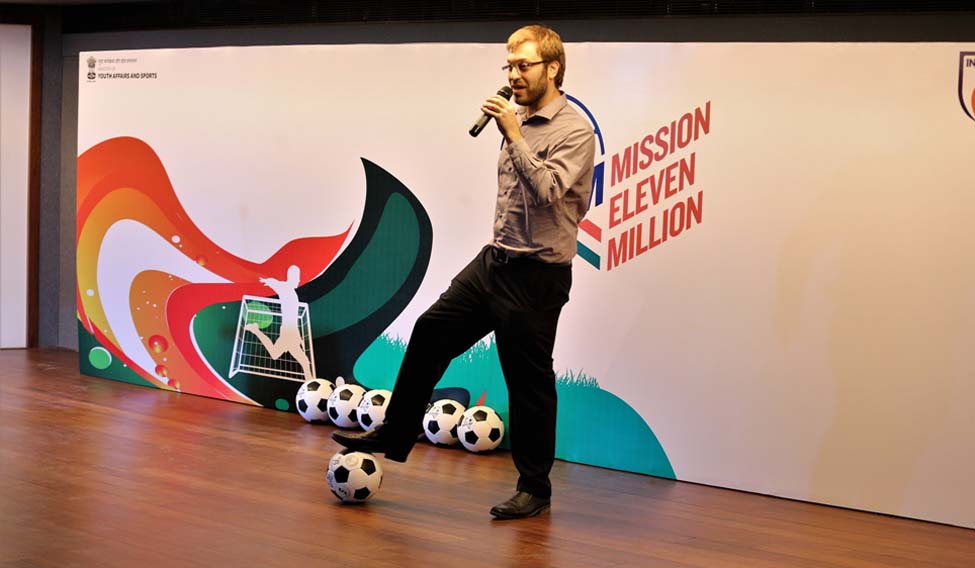Jose Mourinho, during his time at Chelsea, would often ask Vinay Menon, a member of staff and the only Indian at the club, something that continues to be one of world football's mysteries: "How is it that a country of 1.3 billion fails to produce a decent football team?
Being India's second-most watched sport, the question is an overly discussed one, particularly among followers of the game. The yawning gap between the country's interest and the lack of quality in the sport is one of the factors that makes India one of European football's biggest overseas market.
Though football in India is as old as cricket, success on the international front is synonymous only with the latter. The national cricket team is the number one Test team in the world, while the football team is 97th. To say that it is a poor reflection of the talent pool is an understatement.
The burning desire to witness live football of international standards is probably what makes the Indian Super League a crowd-puller. And, it could also explain why ticket sales for this year's FIFA U-17 world cup has been nothing short of overwhelming. The turnout for the event, which will be India's first FIFA event, is going to be unprecedented in the history of the youth competition.
But, the tournament will come and go, before we know it. And, that is where Mission XI Million plays its part—to ensure that such a brand of the sport becomes commonplace in India.
Designed to serve as a legacy programme for the international tournament, MXIM is an initiative of the All India Football Federation (AIFF) and the ministry of youth affairs and sports.
The project seeks to teach football to at least 11 million schoolchildren over 36 cities before the start of the world cup in October. Collaborating with over 15,000 schools, it would, in the process, become India's biggest sports outreach initiative.
The U-17 world cup organisers have been actively promoting the project that will help create an atmosphere for the sport when the event is on. Javier Ceppi, tournament director, wants the programme to "build a new culture for the game in India."
He told THE WEEK that there needs to be a change in perception. "We saw in India that lot of people are interested in football, but they think you can only play it on a full pitch; 11 versus 11," he said.
"When we say that it is perfectly fine to play on any surface of any size, with any number of players, it opens up everyone's mind and they start thinking how easy it is to play football."
The programme organisers had decided to conduct it at a school level, for it to be included as a part of the formal education system. Equipment and technical football manuals were handed to schools, along with support and guidance from the organisers. All this was done after long discussions with FIFA.
On its launch, MXIM had set the bar high—they aimed to reach 11 million children from 15,000 schools. As things stand, more than 11,000 schools have already enrolled and the organisers say that they could reach a figure close to 20,000 by the time the tournament is under way.
Though the project was initially slated to be held in government schools, numerous private schools began showing interest. Ceppi said that projects like these give due importance to physical education teachers, with school administrators acknowledging that sports is part of the integral development of a child.
"This can certainly help in the long run, as a sports grassroots initiative that is primed to help in changing the way sports is seen within the complete educational context," said Ceppi.
Joy Bhattacharjya, project director for the world cup, told THE WEEK that the AIFF had spent resources on developing India's under-17 side in a way not even the senior side has ever received.
Similarly, the football body and the sports ministry have invested Rs25 crore on the MXIM. It is too early to say whether such an investment will pay off, but the AIFF claims to be doing what it can to set the ball rolling (no pun intended), in the hope that schools take it forward earnestly.
The state governments have shown interest and some are even taking over the initiative. Maharashtra is making 10 lakh kids play football; West Bengal is giving around 1 lakh footballs to kids, schools and clubs; Bihar is planning to have a 'football day' and a tournament for MXIM; and Jammu and Kashmir is using it as a tool for development for schoolchildren.
In consultation with FIFA, the final stage of MXIM involves conducting 'football festivals' for the children in every city. Matches, skill contests and distribution of merchandise and prizes are in store for participants at the mela, as well as the chance to hone football techniques.
"Extensive work is being done to host the world cup, and, through MXIM, we are trying to introduce the game to as many kids as possible," said Bhattacharjya. "We do this by incentivising the schools and the children who take part in the programme. We conduct classes, seminars and give constant technical support."
He said that schools were chosen for this programme, over football club academies, as they have a wider reach. Moreover, Ceppi said that MXIM was undertaken in consultation with several local clubs and ISL teams to ensure that the project was in line with the grassroots culture that professional teams want to bring to football.
Once the world cup is over, the AIFF will continue to play a lesser role in furthering the fruits of the project, by giving guidance when necessary. It remains to be seen whether schools will indeed make use of the resources, in a joint effort to eventually produce a national team that is worthy of playing in the senior world cup.
Irrespective of the rise in the standard of the sport in India, it is a given that European football will always be far more entertaining and superior. Expecting Indian football to displace the admiration for club football played in England, for instance, is far-fetched.
What India needs is not a burgeoning class of youngsters who feign interest in European football because it is fashionable, but rather a football culture where actually playing the sport is promoted among children. Getting 11 million children to play should be just the start.






